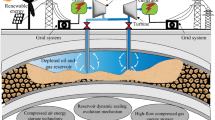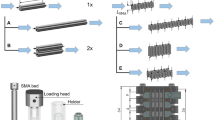Abstract
The idea of adsorption based refrigerator was conceived in the year 1961 by Vickers. The present work reports development of a sorption compressor based J-T refrigerator with R134a alone as a working fluid and a three component mixture of R134a, Ethane and Methane. Commercially available activated carbon, obtained from coconut shell, is used as an adsorbent. The reported compressor is a four cell structure and uses isenthalpic expansion of R134a for cooling purpose. A lowest temperature of −8°C is obtained giving 5 W of refrigeration effect for R134a. The work is further extended to study the effect of various parameters like adsorption-desorption cycle time, heater power input and capillary tube length on the low temperature obtained from the refrigerator. Experiments are then carried out using a three component mixed refrigerant, a low temperature of −54°C at no load is achieved. Also a continuous trouble-free operation is observed.












Similar content being viewed by others
Abbreviations
- EO :
-
characteristic energy of the surface, kJ;
- p:
-
pressure, N/m2;
- ps :
-
saturation pressure, N/m2;
- R:
-
gas constant, J/mol K;
- W:
-
equilibrium adsorption capacity of adsorbent, g/g;
- WO :
-
micropore volume of adsorbent, m3/g;
- βa :
-
shifting factor;
- ρ:
-
density of the working gas, m3/kg;
References
Duband L and Coolaudin B 1999 Sorption coolers development at CEA – SBT. Cryogenics 39: 659–663
Haselden G G 1971 Cryogenic Fundamentals. California: Academic Press chapter, 375p
Parry Robert H and Green Don W 2007 Parry’s Chemical Engineer’s Hand book. New York: Mc Graw-hill Professional, chapter 16
Rane M V, Kota Reddy S V, Agarwal A and Bajaj J S 2003 Energy efficient sorption processes and systems. Pub. No.: US 2003/0221438 A1
Boubakri A 2006 Performance of an adsorptive solar ice maker operating with a single double function heat exchanger (evaporator/condenser). Renewable Energy 31: 1799–1812
Chan C K 1999 Dynamic design of Gas Sorption J-T Refrigerator. Advances in Cryogenics 37: 819–827
Huinik S A J, Burger J F, Holland H J, Van der sar E G, Gardener J G E, Ter Brake H J M and Rogalla H 1997 Experiments on charcoal/nitrogen sorption compressor and model considerations. Cryocooler 9: 569–579
Prasad M, Akkimardi S, Rastogi S C, Rao R and Srinivasan K 1996 Adsorption characteristics of the charcoal-nitrogen system at 79-320 k and pressures to 5 M pa. Carbon 34: 1401–1406
Mehta R N, Bapat S L and Atrey M D 2012 Characterization of Sorption Compressor for Mixed Refrigerant J-T cryocooler. American Institute of Physics, Melville, NY. Advances in Cryogenics 57: 1797–1804
Mehta R N, Bapat S L and Atrey M D 2014 Design and Development of a Four-Cell Sorption Compressor Based J-T cooler using R134a as Working Fluid. Advances in Cryogenics 59B: 1055–1062
Zeng T, Huang Y, Kobayashi N and Li J 2017 Performance of an Activated Carbon-Ammonia Adsorption Refrigeration System. Natural Resources 8: 611–631
Wiegerinck F M, Burger J F, Holland H J, Hondebrink E, Ter Brake H J M and Rogalla H A 2006 sorption compressor with a single sorber bed for use with a Linde–Hampson cold stage. Cryogenics 46: 9–20
Wade L, Ryba E, Weston C and Alvarez J 1992 Test performance of a 2 W, 137 K sorption refrigerator. Cryogenics 32: 122–126
Hutson Nick D and Yang Ralph T 1997 Theoretical Basis for the Dubinin-Radushkevitch (D-R) Adsorption Isotherm Equation. Adsorption 3: 189–195
Wood G O 2001 Affinity coefficients of the Polanyi /Dubinin adsorption isotherm Equations A review with compilations and correlations. Carbon 39: 343–356
Chan C K, Tward E and Boudaia K I 1984 Adsorption isotherms and heats of adsorption of hydrogen, neon and nitrogen on activated charcoal. Cryogenics 34: 256–263
Alvarez J F, Krylo R J, Snapp R D, Weston C, Sywulka P and Bell G C 1997 Development of an Advanced Sorption cooler and its application in a 125 K. Cryocooler 9: 569–579
Walimbe N S, Narayankhedkar K G and Atrey M D 2008 Experimental Investigation of Mixed Refrigerant Joule – Thomson (MR JT) cryocooler. Advances in Cryogenic Engineering 53A: 11–16
Ardhapurkar P M, Sridharan A and Atrey M D 2014 Flow boiling heat transfer coefficients at cryogenic temperatures for multi-component refrigerant mixtures of nitrogen–hydrocarbons. Cryogenics 59: 84–92
Author information
Authors and Affiliations
Corresponding author
Rights and permissions
About this article
Cite this article
MEHTA, R.N., BAPAT, S.L. & ATREY, M.D. Performance evaluation of sorption compressor based J-T refrigerator using R134a and mixture refrigerants as working fluids. Sādhanā 44, 176 (2019). https://doi.org/10.1007/s12046-019-1156-3
Received:
Revised:
Accepted:
Published:
DOI: https://doi.org/10.1007/s12046-019-1156-3




